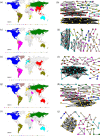Evolving community structure in the international pesticide trade networks
- PMID: 37928009
- PMCID: PMC10623292
- DOI: 10.1016/j.heliyon.2023.e21076
Evolving community structure in the international pesticide trade networks
Abstract
The statistical properties of the international trade networks of all commodities as a whole have been extensively studied. However, the international trade networks of individual commodities often behave differently. Due to the importance of pesticides in agricultural production and food security, we investigated the evolving community structure in the international pesticide trade networks (iPTNs) of five categories from 2007 to 2018. We reveal that the community structures in the undirected and directed iPTNs exhibit regional patterns. However, the regional patterns are very different for undirected and directed networks and for different categories of pesticides. Moreover, the community structure is more stable in the directed iPTNs than in the undirected iPTNs. We also extract the intrinsic community blocks for the directed international trade networks of each pesticide category. It is found that the largest intrinsic community block is the most stable, appears in every pesticide category, and contains important economies (Belgium, Germany, Spain, France, the United Kingdom, Italy, the Netherlands, and Portugal) in Europe. Other important and stable intrinsic community blocks are Canada and the United States in North America, Argentina and Brazil in South America, and Australia and New Zealand in Oceania. These results suggest that, in the international trade of pesticides, geographic distance and the complementarity of important and adjacent economies are significant factors.
Keywords: Community structure; Econophysics; International pesticide trade network; Intrinsic community block; Regional pattern; Temporal network.
© 2023 The Author(s).
Conflict of interest statement
The authors declare that they have no known competing financial interests or personal relationships that could have appeared to influence the work reported in this paper.
Figures















Similar articles
-
Understanding Global Rice Trade Flows: Network Evolution and Implications.Foods. 2023 Sep 2;12(17):3298. doi: 10.3390/foods12173298. Foods. 2023. PMID: 37685236 Free PMC article.
-
Robustness and efficiency of international pesticide trade networks subject to link removal strategies.Sci Rep. 2022 Nov 16;12(1):19641. doi: 10.1038/s41598-022-21777-1. Sci Rep. 2022. PMID: 36385189 Free PMC article.
-
News, views, trends: a world-wide survey of recent developments, fresh ideas and production plans.World Tob. 1976 Oct;(54):43-54. World Tob. 1976. PMID: 12279414
-
Characteristics of current international trade of live salmonid eggs.Rev Sci Tech. 1996 Jun;15(2):423-33. doi: 10.20506/rst.15.2.930. Rev Sci Tech. 1996. PMID: 8890373 Review.
-
A review of the global pesticide legislation and the scale of challenge in reaching the global harmonization of food safety standards.Integr Environ Assess Manag. 2015 Oct;11(4):525-36. doi: 10.1002/ieam.1635. Epub 2015 Apr 30. Integr Environ Assess Manag. 2015. PMID: 25765969 Review.
References
-
- Food Security Information Network . May 2021. https://www.wfp.org/publications/global-report-food-crises-2021 Global Report on Food Crises 2021.
-
- Garlaschelli D., Loffredo M.I. Structure and evolution of the world trade network. Physica A. 2005;355:138–144. doi: 10.1016/j.physa.2005.02.075. - DOI
-
- Garlaschelli D., Di Matteo T., Aste T., Caldarelli G., Loffredo M.I. Interplay between topology and dynamics in the world trade web. Eur. Phys. J. B. 2007;57:159–164. doi: 10.1140/epjb/e2007-00131-6. - DOI
LinkOut - more resources
Full Text Sources

